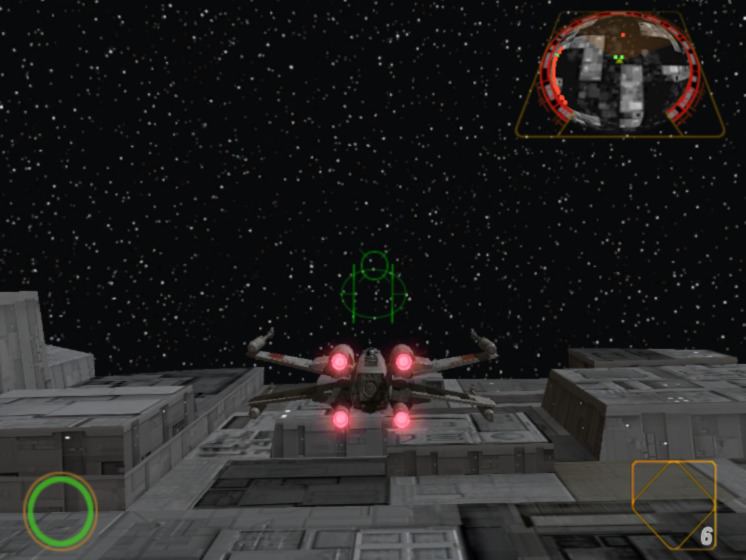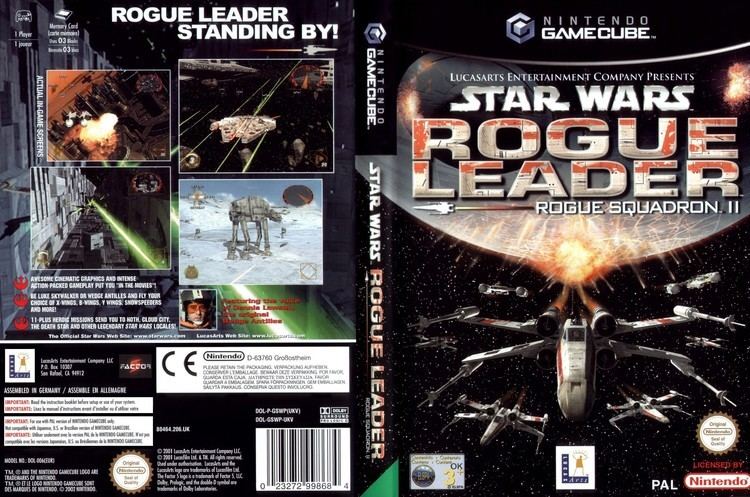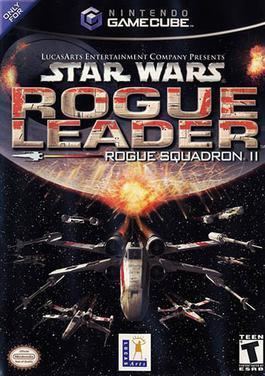9.2 /10 1 Votes9.2
9.4/10 GameSpot Initial release date 18 November 2001 | 9.1/10 IGN 90% GameFAQs | |||||||||||||||||||||||||||||||||
Composer(s) Chris HülsbeckJohn Williams (themes) Publishers LucasArts, Activision, Square Similar LucasArts games, Shooter games | ||||||||||||||||||||||||||||||||||
Star wars rogue squadron ii rogue leader vengeance on kothlis
Star Wars Rogue Squadron II: Rogue Leader (also known as Star Wars Rogue Leader: Rogue Squadron II) is an action game co-developed by Factor 5 and LucasArts The second of three games in the Rogue Squadron series, it was published by LucasArts in North America in Europe version published by Activision and Japanese version published by Electronic Arts and Squaresoft joint venture Electronic Arts Square. and released as a launch title for the GameCube in North American on November 9, 2001 and Europe on May 3, 2002.
Contents
- Star wars rogue squadron ii rogue leader vengeance on kothlis
- Star wars rogue squadron ii rogue leader tatooine training
- Gameplay
- Unlockable content
- Setting
- Plot
- Development
- Reception
- Sales
- References

Set in the fictional Star Wars galaxy, the game spans all three original trilogy Star Wars films. The player controls Luke Skywalker and Wedge Antilles. As the game progresses, Skywalker, Antilles and the Rebel Alliance fight the Galactic Empire in ten missions across various planets.

Star wars rogue squadron ii rogue leader tatooine training
Gameplay

Similar to its predecessor, Star Wars: Rogue Squadron, Rogue Leader is a fast-paced, flight action game. Each of the game's ten levels introduces mission objectives such as search and destroy or protection that must be completed to progress to the next level. Enemy aircraft are primarily composed of TIE fighters, Imperial shuttles and Star Destroyers. Ground defenses are more varied and include three different walkers, various laser turrets, probe droids and stormtroopers.

The heads-up display features a health meter, a radar, an ammunition count for secondary weapons and the "command cross" that allows the player to give limited instructions to their wingmen. The player can control seven craft in the base game: X-wing, A-wing, Y-wing, B-wing, Snowspeeder, the T-16 Skyhopper and the Millennium Falcon. Each vehicle offers a unique armament arrangement, as well as varying degrees of speed and maneuverability. The game initially restricts the player to a particular craft for each level; however, after a level is completed, it can be replayed with any available craft. Some levels offer the player the option to change craft mid-level. Eleven bonus power-ups are hidden in different levels throughout the game. These bonuses improve a craft's weapons, durability and targeting computer and are applied to each eligible craft for the remainder of the game.

The player's performance is measured throughout the game, and performance statistics are checked after each level against three medal benchmarks. Each benchmark contains six categories: completion time, number of enemies destroyed, shot accuracy, number of friendly craft and structures saved, number of lives lost and targeting computer efficiency. If a player's performance meets or exceeds one of the level's three benchmarks in all six categories, a medal—bronze, silver or gold—is awarded on completion. Acquiring these medals promotes the player's rank and helps unlock hidden content. Once the player completes all of the training missions and achieves gold medals on all 15 levels, the opportunity to activate "Ace Mode" is awarded. The player may then achieve one more medal per level by completing them with this mode activated.
Unlockable content
Rogue Leader includes a number of unlockable secrets. The player can unlock five bonus levels. Two of these levels allow the player to pilot the Millennium Falcon, while two others allow the player to fight against the Rebel Alliance as Darth Vader. The fifth unlockable level pits the player against 99 waves of enemy fighters. These levels can be purchased after the player obtains enough points accumulated via the game's medal system. Alternatively, they can be unlocked via password. Several craft are also available when unlocked. The Millennium Falcon, the TIE advanced, an Imperial shuttle and the Slave I may be selected after the player meets or exceeds various medal requirements or enters the corresponding passwords. A Naboo Starfighter and a TIE fighter may also be selected after the player completes in-game tasks dependent on the time as dictated by the GameCube's real-time clock. A playable model of a 1969 Buick Electra 225 based on a car owned by the game's sound designer, Rudolph Stember, can be unlocked via password only. The complex scrambling system developed for Star Wars: Rogue Squadron to help hide a code from gamers using game-altering devices such as GameShark or ProAction Replay also made a return. This time it is used to hide a password-only alternate color scheme for Slave I, as seen in Star Wars: Episode II – Attack of the Clones. Slave I could be restored to its original color scheme by entering the password a second time.
Setting
Star Wars Rogue Squadron II: Rogue Leader is set in the fictional Star Wars galaxy, where a war is fought between the Galactic Empire and the Rebel Alliance. The game spans all three original trilogy Star Wars films: A New Hope, The Empire Strikes Back and Return of the Jedi. Luke Skywalker and Wedge Antilles have recently joined the Alliance to help defeat the Empire and restore freedom to the galaxy.
Plot
The game opens with an opening crawl resembling those featured in the Star Wars films. Further story details are presented through the game's instruction manual, pre-mission briefings, character conversations during the game, in-game cut scenes and movie clips lifted directly from Star Wars films. The game begins with the Rebel Alliance launching an attack on the Death Star, the Galactic Empire's largest space station. In a reenactment of A New Hope's climactic battle, Luke Skywalker destroys the Death Star after firing into an exhaust port.
Skywalker and Wedge Antilles then accompany a Rebel supply convoy from Yavin IV to Hoth. When attempting to rendezvous with a second convoy in the Ison Corridor, they discover that the convoy has been destroyed and are ambushed. After fighting off the attack, the Rebels continue on to Hoth. As depicted in The Empire Strikes Back, Imperial forces locate the Rebel base on Hoth and begin an invasion. Despite Skywalker crash-landing, Rogue Squadron is able to hold off the Imperial attack force long enough for the Rebel base to sufficiently evacuate.
A secret Imperial installation is then located in The Maw. As the Antilles-led Rogue Squadron approaches the base, they receive a transmission from a prisoner who identifies herself as Rebel Karie Neth, a Rebel who was taken prisoner after the battle of Hoth. Neth informs Rogue Squadron that she and a few others have escaped from the prison, but need help freeing the remaining Rebel prisoners. By providing cover fire, Rogue Squadron is able to successfully escort the prisoners out of the base. Skywalker then obtains data important to the rebellion, and Rogue Squadron is asked to escort the blockade runner carrying the data to Rebel high command. However, the blockade runner is captured by an Imperial Star Destroyer while orbiting Kothlis. After the Rebels disable the Star Destroyer, it crashes on Kothlis and Crix Madine retrieves the data.
The Alliance soon discovers that the Empire is constructing a second Death Star near Endor. With the help of Madine, Antilles infiltrates the Imperial Academy on Prefsbelt IV and steals an Imperial shuttle needed to get close enough to destroy a shield generator on Endor. The Rebel fleet then begins to assemble near Sullust but needs tibanna gas for its weapons. Lando Calrissian points the Rebels to his former tibanna-mining operation near Cloud City on Bespin. Rogue Squadron raids the now-Imperial-controlled facility and secures the gas supply.
In a reenactment of Return of the Jedi's climactic space battle, the Alliance then launches its attack on the second Death Star. When they arrive, however, Han Solo has not yet disabled the Death Star's shield generator on Endor and the Alliance is forced to engage the Imperial fleet until the generator is destroyed. Once the space station is vulnerable, Calrissian and Antilles fly into the Death Star and destroy its power generator, effectively destroying the entire structure.
Development
When Factor 5 received early GameCube prototype hardware in mid-2000, the development team then working on Star Wars: Episode I: Battle for Naboo decided they next wanted to create a direct sequel to Factor 5's most successful game to date—Star Wars: Rogue Squadron. With LucasArts' approval, the team immediately began developing a tech demo to exhibit at Space World, a Nintendo-hosted trade show. In 19 days, Factor 5 produced an introductory cutscene that emulated a scene from Star Wars and a playable demo, which then premiered alongside Nintendo's GameCube hardware at the show. According to GameSpot, the cutscene "wowed audiences", and IGN described the demo as "drop-dead gorgeous".
As with Rogue Squadron and Battle for Naboo, Rogue Leader was again co-developed by Factor 5 and LucasArts, however the bulk of the game's development was done by Factor 5. Unlike past co-development efforts, the bulk of the level design, which was traditionally handled by LucasArts, was created by Factor 5 in addition to the game's engineering and programming. Factor 5's in-house development team consisted of 25 members plus two freelance employees. One level designer as well as the game's lead artist were employed by LucasArts. Development of the game's art started that same year. In anticipation of the project, modelers immediately began building high-polygon models of the playable craft using Maya and in-house tools, and usable art was pulled from the archives. In late December, 2000, mission designers met with director Julian Eggebrecht and producer Brett Tosti to start planning the game engine. The team eventually completed Battle for Naboo, and full-time development of Rogue Leader began in February 2001.
Draw distance, much improved over the first Rogue Squadron and Battle for Naboo, was drawn out as far as possible. A small amount of haze was deliberately added to create a sense of distance, but not to actually hide the drawing. The game also has three levels of detail; The closer the player comes to objects, the more detailed they become. By utilizing the GameCube's Graphics processing unit's TEV pipeline, Factor 5 was able to create the shader needed to produce the visual effect employed by the game's targeting computer. The developers tried to make the game as close to the movies as possible, studying Industrial Light & Magic's special effects, using some of the same sound effects, music and voice acting from the films. The original actor, Denis Lawson, was also hired to record new lines for Wedge Antilles.
Reception
The game was met with critical acclaim, as GameRankings gave it a score of 90.04%, while Metacritic gave it 90 out of 100. David Trammell of Nintendo World Report gave it nine out of ten and called it "a visual and aural masterpiece. The game has all the bells and whistles you'd expect from a next-generation game including bump mapping and 480p support on the visual end, and five channel surround sound via Dolby Pro Logic II on the aural end." Marc Saltzman of Playboy gave it a score of 90% and stated that, "The combined package of beautiful graphics, intense action (including force-feedback rumble support in the controller!) and familiar Star Wars ditties all work together to create an immersive, outstanding experience from beginning to end." In The Cincinnati Enquirer, he gave the game four stars out of five and stated that, "If there was ever a reason to purchase this compact new console, this is it... [but] there's no multiplayer mode. It would have been fun to fly alongside or against another player in some of the missions." Alex Porter of Maxim gave it a similar score of eight out of ten and said: "More than a Jedi mind trick to make you buy Nintendo's new whiz-bang console, this is the closest a video game has come to recreating a Star Wars movie."
Rogue Leader was among the highest rated GameCube launch titles, and praised for its gameplay and graphics. Official Nintendo Magazine ranked it the 100th best game available on Nintendo platforms. The staff called it an essential launch title for the GameCube.
Rogue Leader won the E3 2001 Game Critics Award for Best Action Game.
Sales
Rogue Leader was the 7th-best-selling video game in November 2001, the title's debut month. These sale figures made the game the best-selling third-party and second-best-selling overall GameCube game during the console's launch. LucasArts stated that the title had sold faster than any of its previously published games at the time. When both the game and console were launched in the United Kingdom over six months later, the title entered the charts at number one, making it the first ever third-party game to hit the top spot during a console's launch. In May 2003, Nintendo added Rogue Leader to its best-selling Player's Choice collection. Rogue Leader sold over 873,000 copies in the United States, and over 100,000 in the UK.
